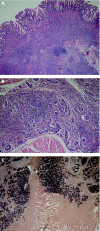Epstein Barr virus-associated tumours: an update for the attention of the working pathologist
- PMID: 17873116
- PMCID: PMC2095566
- DOI: 10.1136/jcp.2006.044586
Epstein Barr virus-associated tumours: an update for the attention of the working pathologist
Abstract
Epstein-Barr virus (EBV) is a herpesvirus associated with approximately 1% of tumours worldwide. EBV is the epitome of B lymphotropic viruses, but the spectrum of tumours it is associated with extends to T lymphocyte and NK cell malignancies, various types of carcinomas and smooth muscle tumours. Ubiquitous EBV infection in humans implies that most individuals carry EBV-infected cells. Therefore, mere detection of the virus in individuals with a tumour is not sufficient for establishing a causal relationship between both events, but instead requires unequivocal detection of viral nucleic acids or viral proteins in the tumour cells. Recent controversies about EBV infection in several carcinomas mainly resulted from such technical issues. The gold standard remains in situ EBER detection, but detection of EBNA1 would be an interesting alternative. EBV detection can be helpful for diagnostic, prognostic and therapeutic purposes. The rate of EBV association with entities such as NK/T cell tumours of the nasal type is so high that absence of detection of the virus in such a lesion should cast doubt of the accuracy of the diagnosis. Similarly, diagnosis of EBV-associated follicular pseudo-tumour obviously requires detection of the virus. EBV-positive common gastric adenocarcinomas seem to have a better prognosis than their EBV-negative counterparts and identification of the virus in B cell lymphoproliferations in immunocompromised individuals will guide therapeutic options. In conclusion, EBV-associated tumours are common enough to be relevant for the pathologist in everyday practice, but there is a need to facilitate detection of the virus (eg EBNA1 antibody).
Conflict of interest statement
Competing interests: None declared.
References
-
- Rickinson A B, Kieff E D. Epstein–Barr virus. In: Knipe DM HP, Griffin DE, Lamb RA, Martin MA, Roizman B, Straus SE, eds. Field virology, 5th edn. Philadelphia: Lippincott Williams & Wilkins 20072655–2700.
-
- Howley P M, Douglas R L. Papillomaviruses. In: Knipe DM HP, Griffin DE, Lamb RA, Martin MA, Roizman B, Straus SE, eds. Field virology, 5th edn. Philadelphia: Lippincott Williams & Wilkins 20072299–2354.
-
- Kieff E D, Rickinson A B. Epstein–Barr virus and its replication. In: Knipe DM HP, Griffin DE, Lamb RA, Martin MA, Roizman B, Straus SE, eds. Field virology, 5th edn. Philadelphia: Lippincott Williams & Wilkins 20072603–2654.
-
- Thorley‐Lawson D A, Gross A. Persistence of the Epstein–Barr virus and the origins of associated lymphomas. N Engl J Med 20043501328–1337. - PubMed
Publication types
MeSH terms
Substances
LinkOut - more resources
Full Text Sources
Other Literature Sources
Miscellaneous


